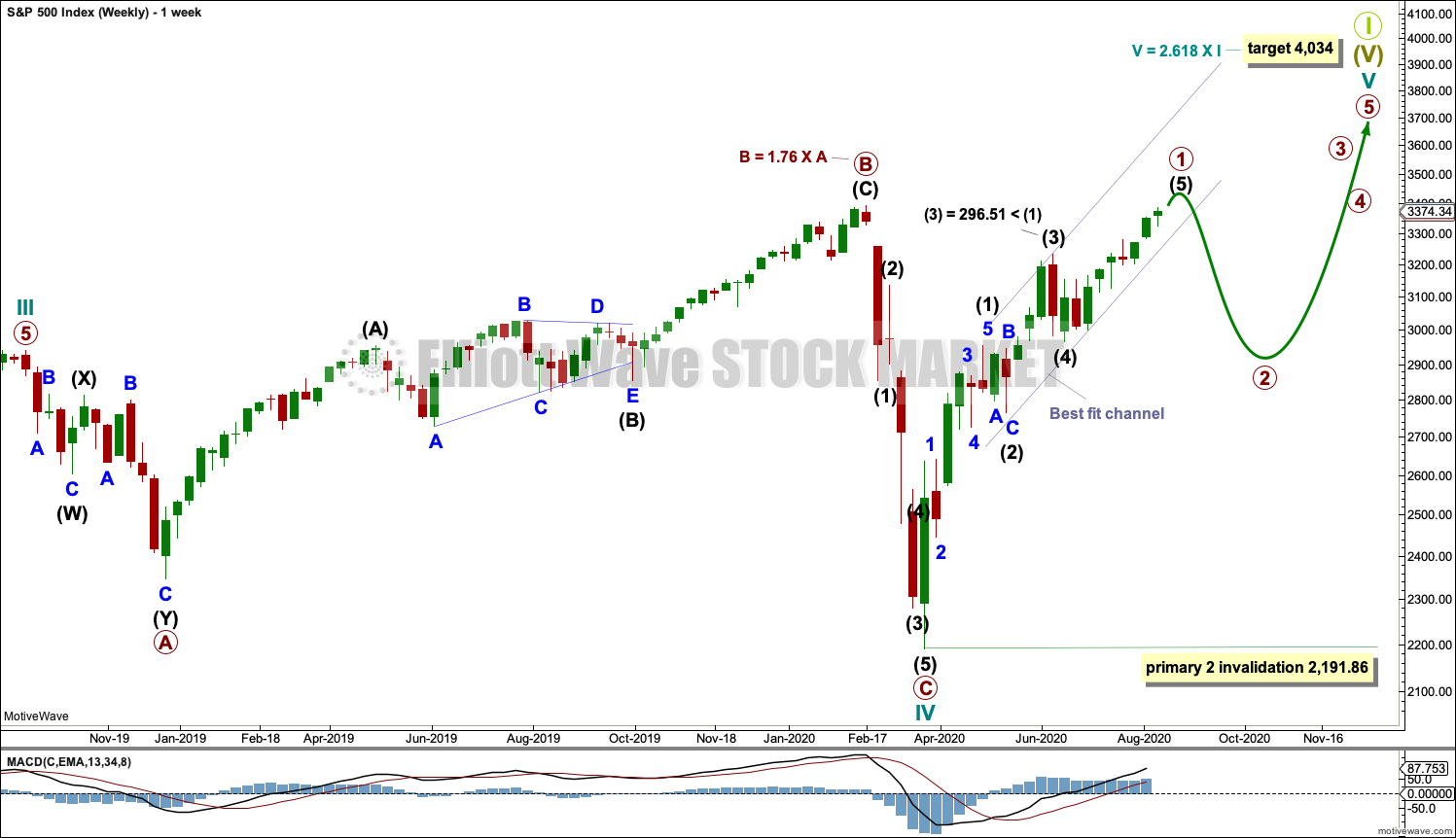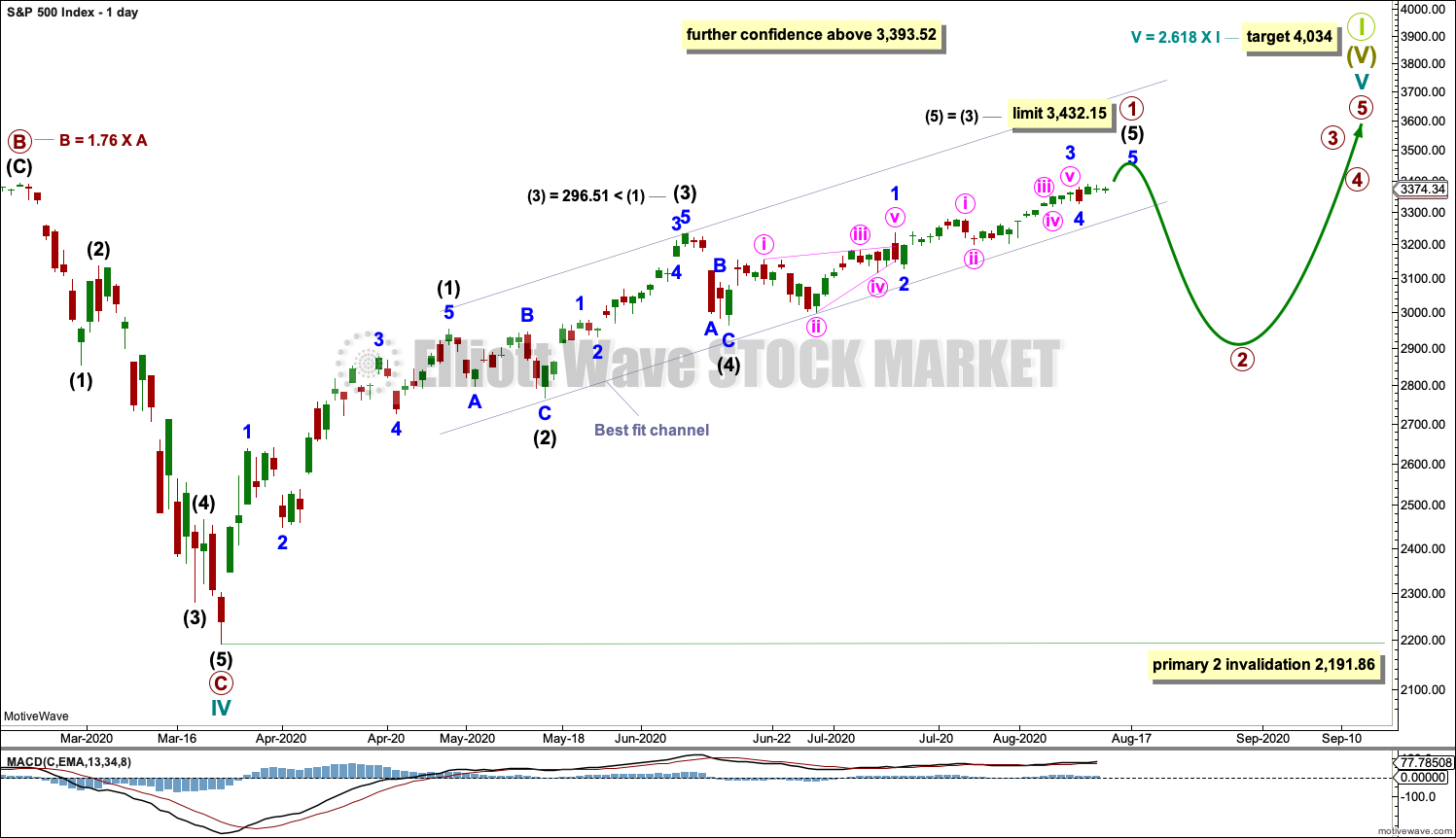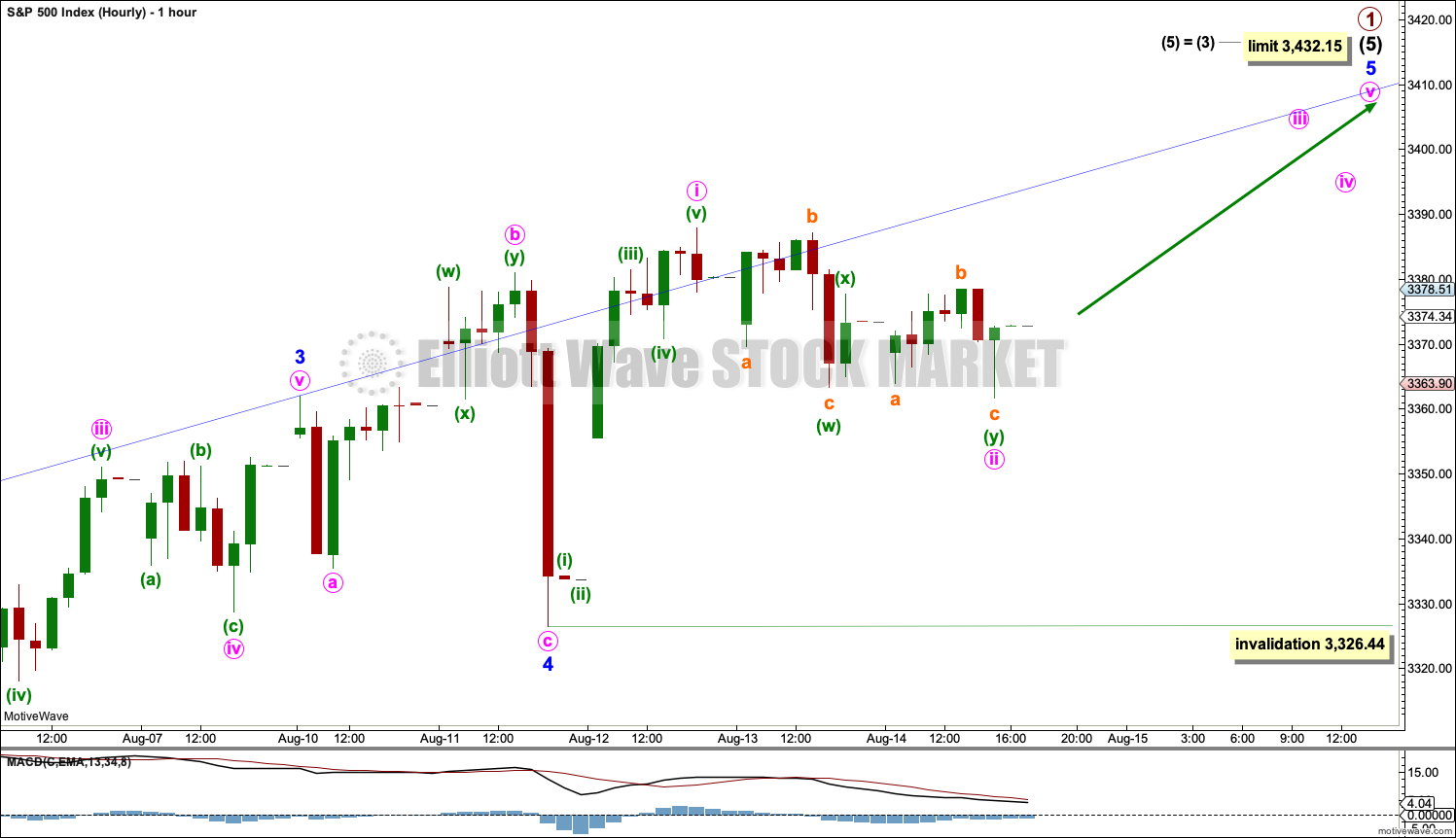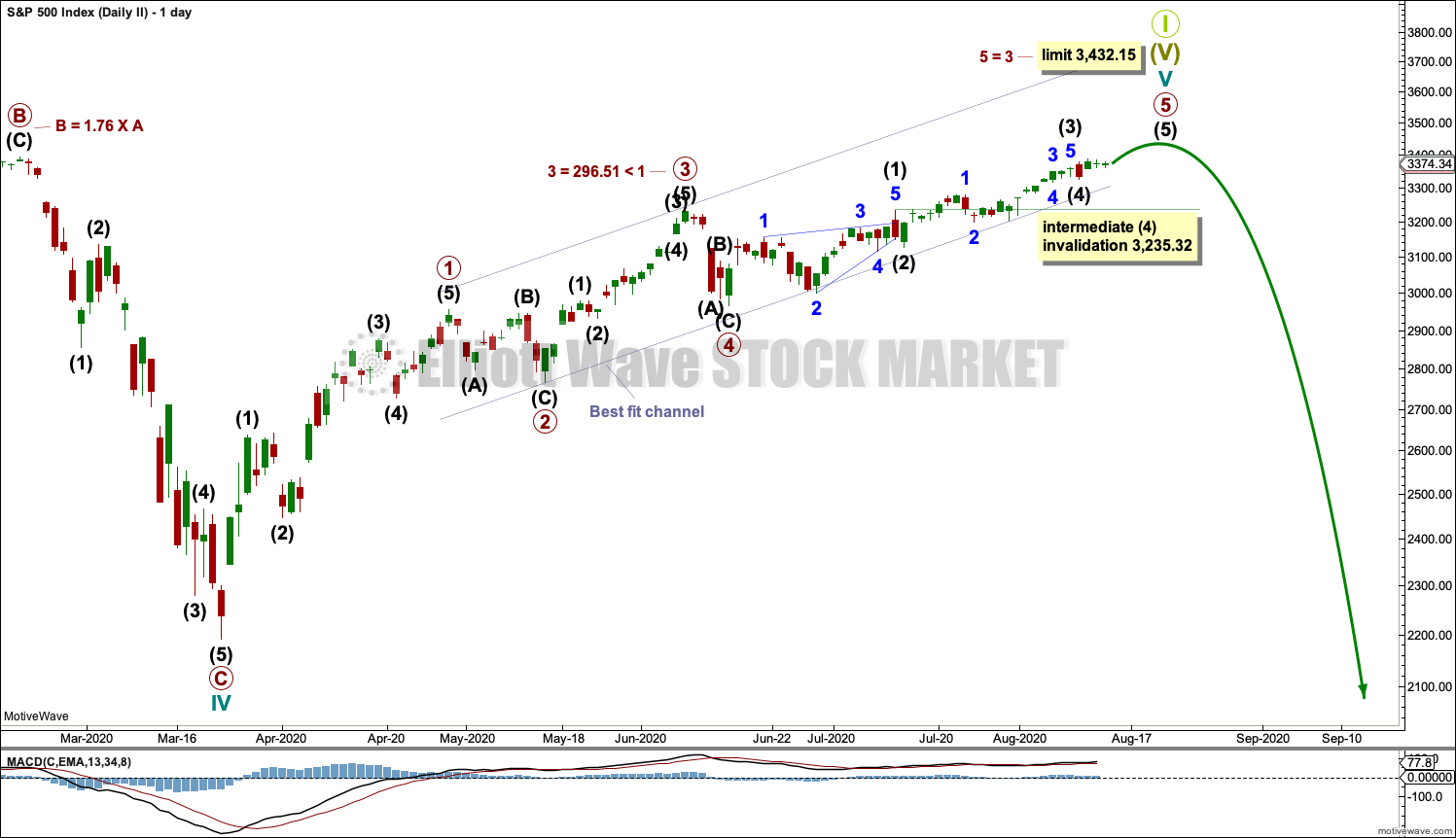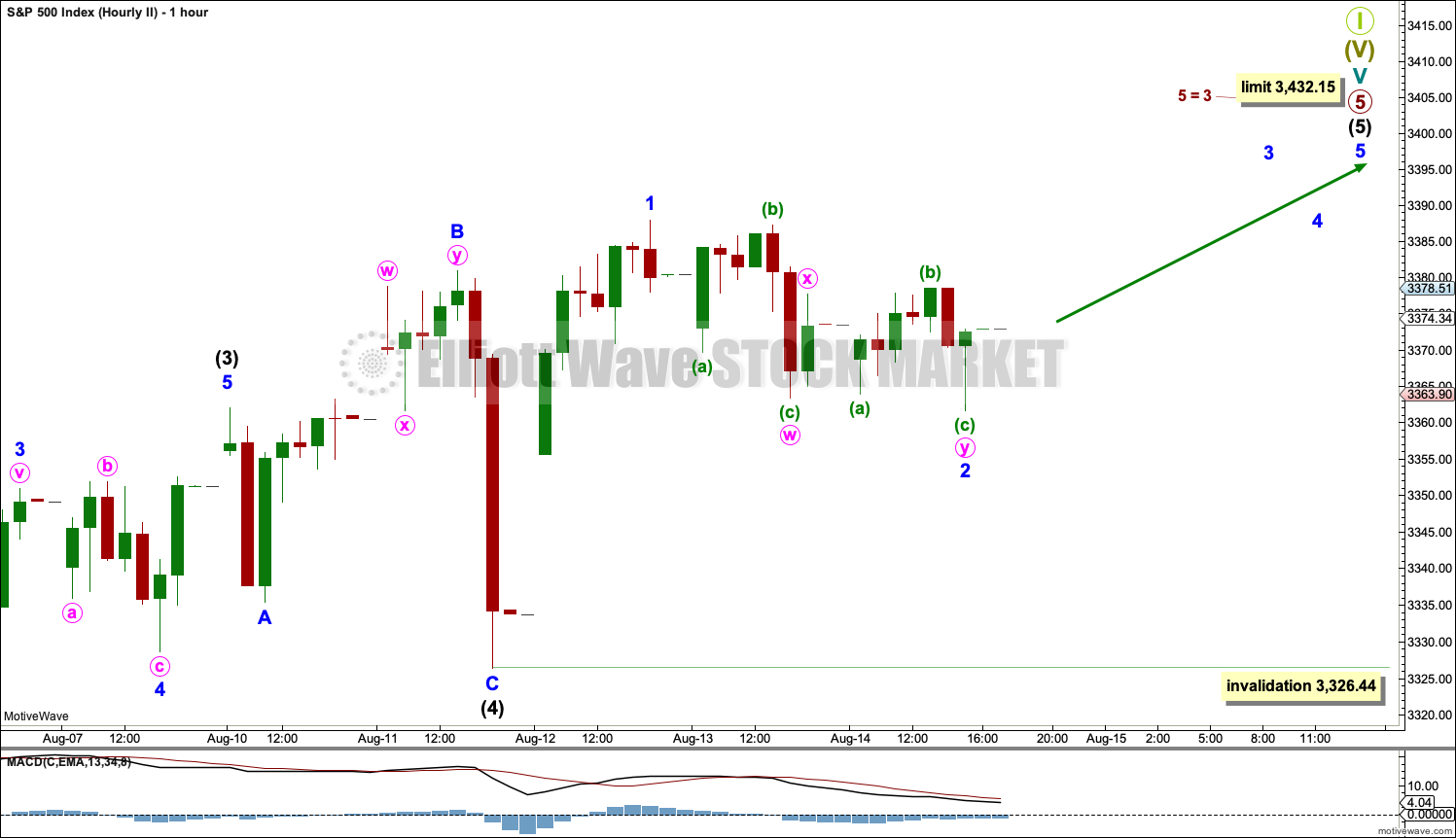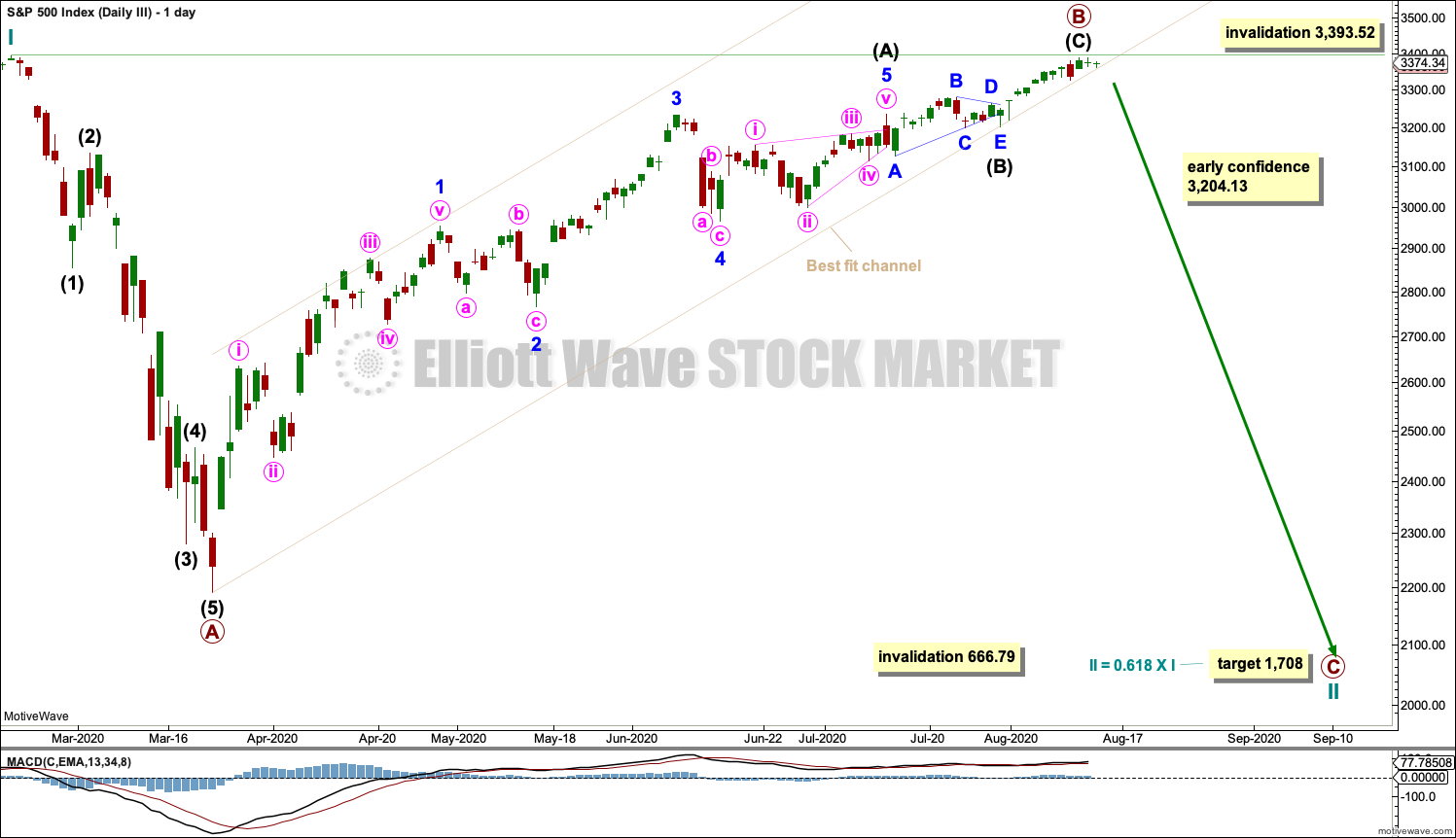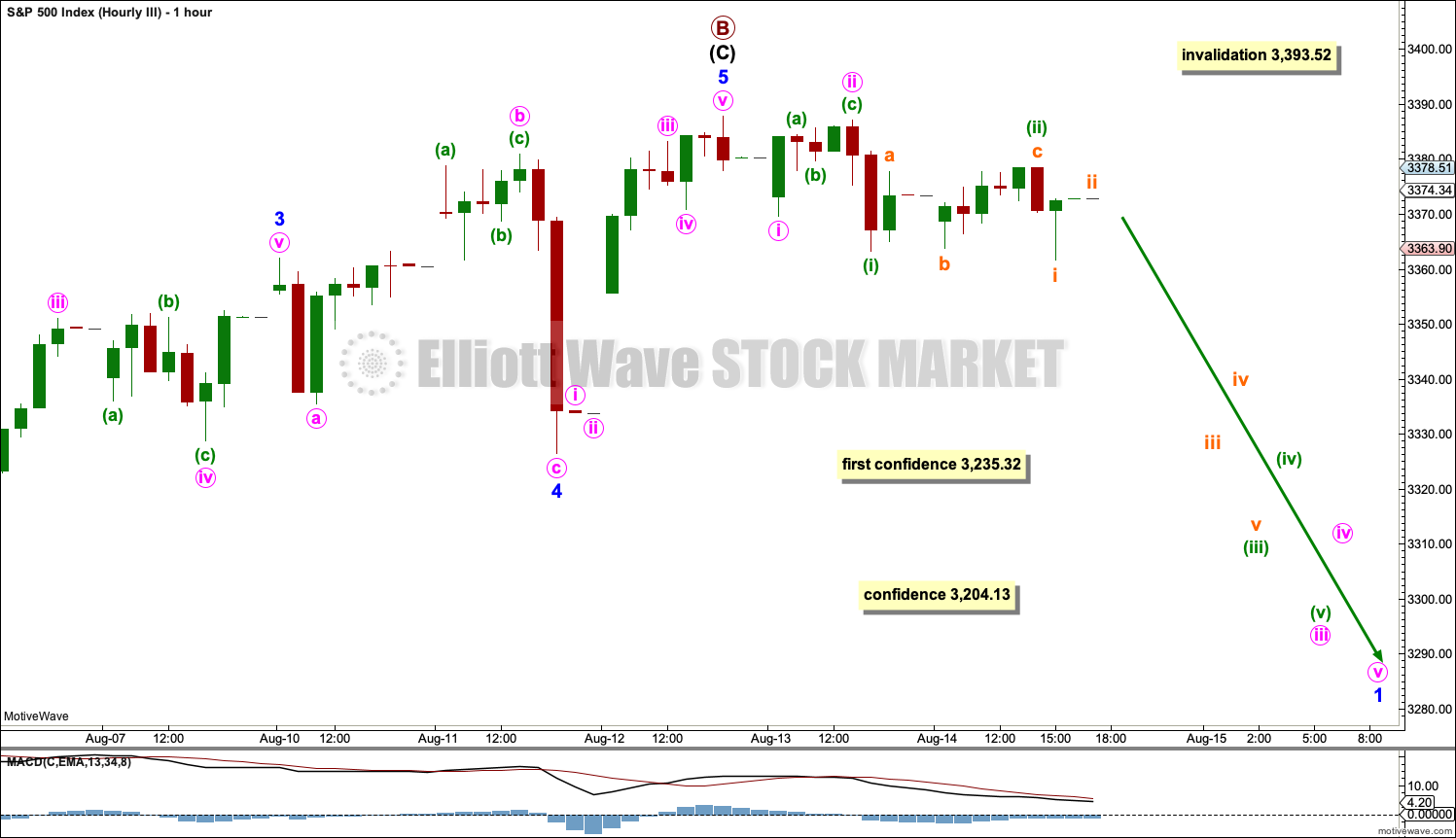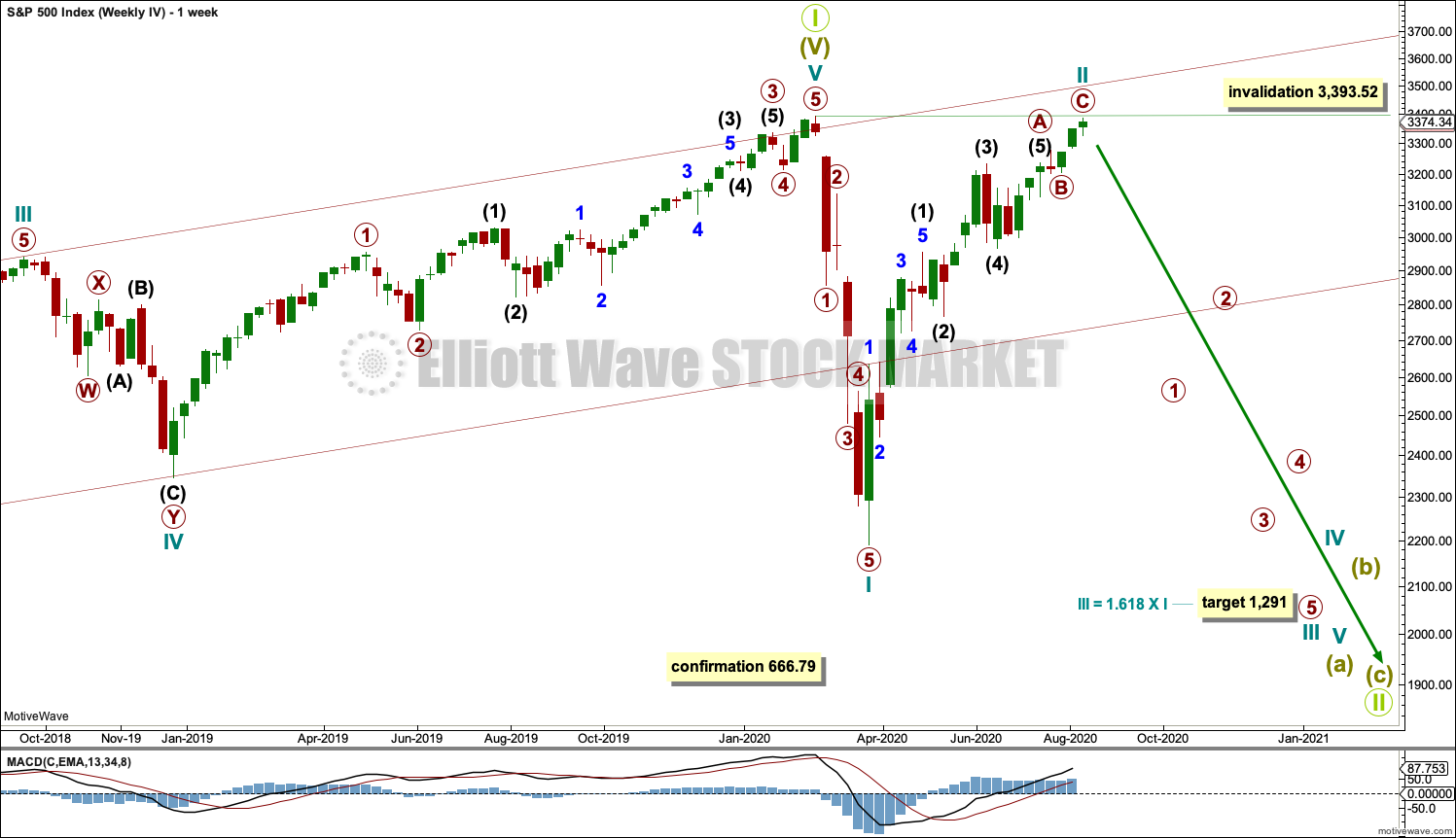S&P 500: Elliott Wave and Technical Analysis | Charts – August 14, 2020
Another small range day closes as an inside day. At the end of the week, all four Elliott wave counts remain the same.
Summary: The trend remains upwards.
A trend change may come before 3,432.15. Prior to this point a multi-week pullback or a 180° reversal may occur.
Bearish wave counts remain valid while price remains below the all time high.
The biggest picture, Grand Super Cycle analysis, is here.
Monthly charts are here, with video here.
ELLIOTT WAVE COUNTS
FIRST WAVE COUNT
WEEKLY CHART
Confidence in this wave count may be had if price makes a new all time high above 3,393.52.
Cycle wave V may last from one to several years.
Cycle wave V may be underway and would most likely subdivide as an impulse. But if overlapping develops, then an ending diagonal should be considered. This chart considers the more common impulse.
Primary wave 1 may be nearing completion. Primary wave 2 may not move beyond the start of primary wave 1 below 2,191.86.
DAILY CHART
The target for the end of this bull market is provisional. It would best be calculated at primary degree, but that cannot be done until all of primary waves 1 through to 4 are complete. At that stage, the target will be recalculated and will very likely change.
Cycle wave V must subdivide as a five wave motive structure, most likely an impulse. Primary wave 1 within cycle wave V may again be incomplete. Look for corrections to find support about the lower edge of the best fit channel while primary wave 1 continues higher. If this channel is breached, then that may provide early indication that primary wave 1 may be over.
When it arrives, primary wave 2 may unfold as a multi-week pullback and may not move beyond the start of primary wave 1 below 2,191.86.
HOURLY CHART
The hourly chart focusses on the middle of minor wave 3 from the end of minute wave ii within it.
Minor wave 4 may have unfolded as an expanded flat correction. This provides alternation with the zigzag of minor wave 2. There is good proportion between the two corrections, which gives the wave count the right look.
Minor wave 5 must subdivide as a five wave structure. Minute wave ii within minor wave 5 may not move beyond the start of minute wave i below 3,326.44.
Minute wave ii may have continued sideways as a double combination or double flat.
SECOND WAVE COUNT
DAILY CHART
This wave count is the same as the first wave count with the exception of the degree of labelling within cycle wave V. If the degree of labelling is moved up one degree, then it is possible that cycle wave V to end Super cycle wave (V) to end Grand Super Cycle wave I is very close to completion.
Primary waves 1 through to 4 within cycle wave V may be complete. Primary wave 5 may end now at any stage. If it continues further, then intermediate wave (4) may not move into intermediate wave (1) price territory below 3,235.32. At this stage, a new low below 3,235.32 could not be part of intermediate wave (4) and would indicate an end to primary wave 5.
Cycle wave V has moved above the end of cycle wave I at 2,940.91, avoiding a truncation. It would still be likely for this wave count that cycle wave V would move above the price territory of cycle wave IV to make a new high above 3,393.52.
HOURLY CHART
At the hourly chart level, this wave count is exactly the same as the first wave count with the sole exception being the degree of labelling. Here, the degree of labelling is one degree higher.
THIRD WAVE COUNT
WEEKLY CHART
The probability of this wave count is reduced with closure of the gap created on the 24th of February.
Cycle wave II would most likely subdivide as a zigzag; thus far that looks like what is unfolding. Primary wave B may again be complete.
Cycle wave II may not move beyond the start of cycle wave I below 666.79.
DAILY CHART
Cycle wave II may subdivide as any Elliott wave corrective structure except a triangle. It would most likely be a zigzag (zigzags subdivide 5-3-5).
Minor wave A may have ended on the 13th of July with an ending contracting diagonal for minor wave 5, followed by a running contracting triangle for intermediate wave (B).
Primary wave B may again be complete.
If primary wave A is correctly labelled as a five wave impulse, then primary wave B may not move beyond the start of primary wave A above 3,393.52.
HOURLY CHART
Intermediate wave (C) must subdivide as a five wave motive structure, most likely an impulse. It is again possible today that intermediate wave (C) and so primary wave B may be complete.
A new low below 3,235.32 (the high of minor wave 1) may not be part of minor wave 4 as minor wave 4 may not move into minor wave 1 price territory. A breach of this price point would add confidence in the view of a high in place.
A new low now below the start of intermediate wave (C) at 3,204.13 could not be a second wave correction within intermediate wave (C), so at that stage intermediate wave (C) would have to be over. A new low below 3,204.13 would provide further confidence that a high may be in place.
FOURTH WAVE COUNT
WEEKLY CHART
By simply moving the degree of labelling in the bull market beginning March 2009 up one degree, it is possible that a Grand Super Cycle trend change occurred on February 19, 2020. The bull market from March 2009 to February 2020 may have been a complete fifth wave labelled Super Cycle wave (V).
A bear market at Grand Super Cycle degree may be expected to last at least a decade, possibly longer. Corrections for this market tend to be much quicker than bullish moves, and so a fair amount of flexibility is required in expectations for duration of the different degrees.
Grand Super Cycle II would most likely subdivide as a zigzag, although it may be any corrective structure except a triangle. It should begin with a five down at the weekly chart time frame, which would be incomplete.
The first wave down on the daily chart is labelled cycle wave I. If this degree of labelling is wrong, it may be too high; it may need to be moved down one degree.
Following cycle wave I, cycle wave II may be a complete single zigzag.
If it continues any higher, then cycle wave II may not move beyond the start of cycle wave I above 3,393.52.
TECHNICAL ANALYSIS
WEEKLY CHART
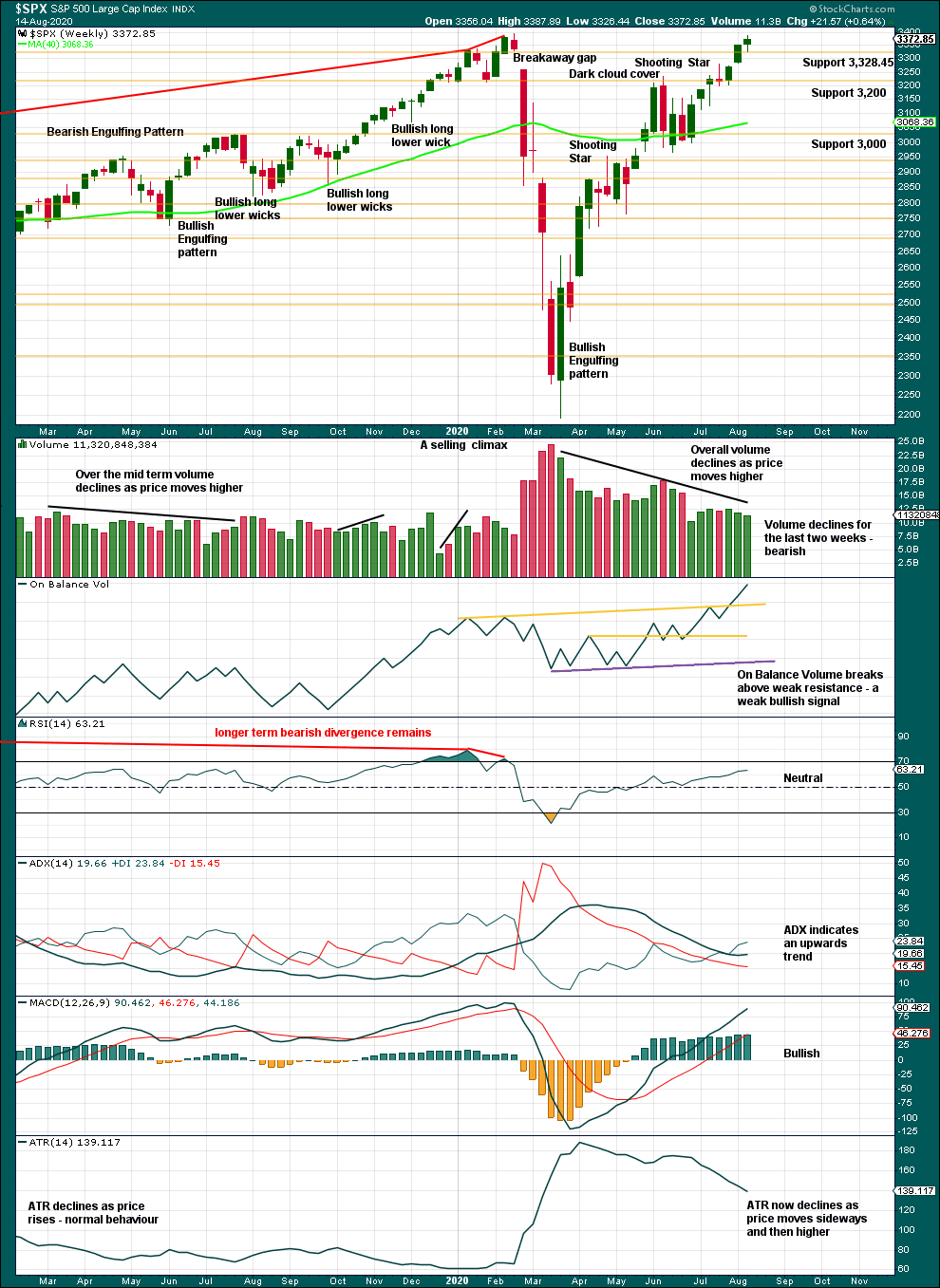
Click chart to enlarge. Chart courtesy of StockCharts.com.
A decline in range and volume this week indicates weakness. There is strong resistance here at the last all time high at 3,393.52. If this can be overcome, then expect some energy to be released and to see price move up with a little more strength.
RSI is not overbought; there is room for upwards movement to continue.
DAILY CHART

Click chart to enlarge. Chart courtesy of StockCharts.com.
The breakaway gap of 24th February has its upper edge at 3,328.45. This gap is now closed. A more bullish analysis expecting new all time highs has now increased in probability.
A target from the flag pole would be at 3,405. This supports the first Elliott wave count.
Double bearish divergence between price and RSI has weakened to only now single bearish divergence, and has further weakened as price continues higher.
RSI and ADX are not extreme; there is room for upwards movement to continue.
For the short term, volume is now more bearish. Declining volume and range has long been a feature of this bull market, but for the last two sessions it is more extreme. Price has been unable to break above resistance so far at the last all time high, which is significant. For a more bullish outlook to prevail that resistance must be overcome next week.
BREADTH – AD LINE
WEEKLY CHART
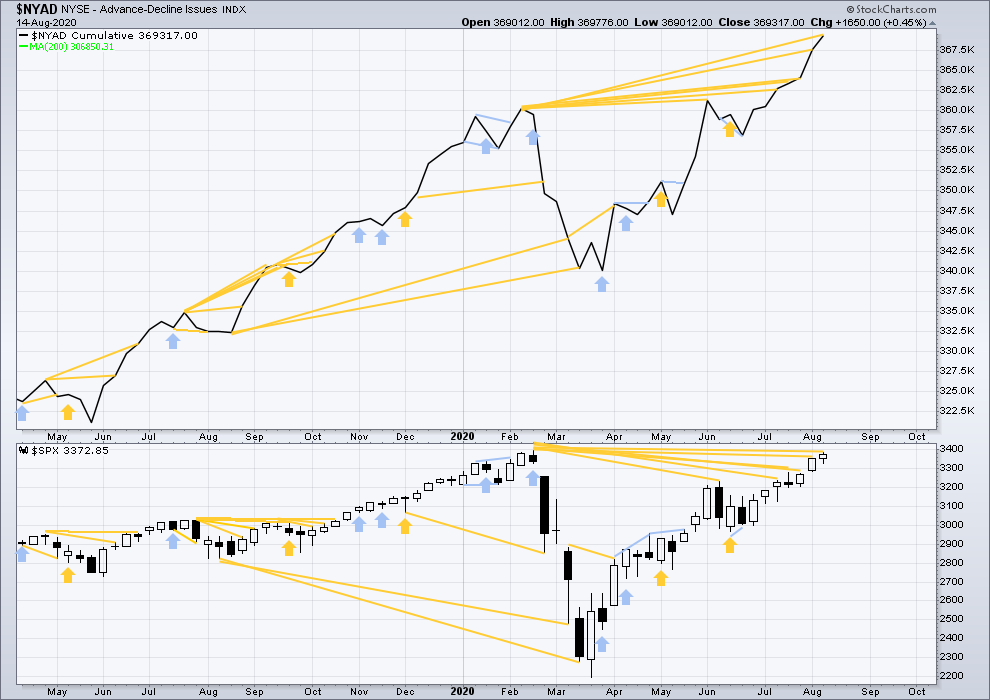
Click chart to enlarge. Chart courtesy of StockCharts.com. So that colour blind members are included, bearish signals will be noted with blue and bullish signals with yellow.
Breadth should be read as a leading indicator.
Last week the NYSE all issues AD line has made another new all time high, although Lowry’s Operating Companies Only AD line still has not. This divergence is bullish and noted on this chart, but failure of the OCO AD line to confirm this divergence reduces the strength of the signal.
Large caps all time high: 3,393.52 on 19th February 2020.
Mid caps all time high: 2,109.43 on 20th February 2020.
Small caps all time high: 1,100.58 on 27th August 2018.
All of small, mid and large caps have now made new swing highs above the prior highs of the 8th of June. This last rise was led by large caps, which is a feature of an aged bull market.
DAILY CHART
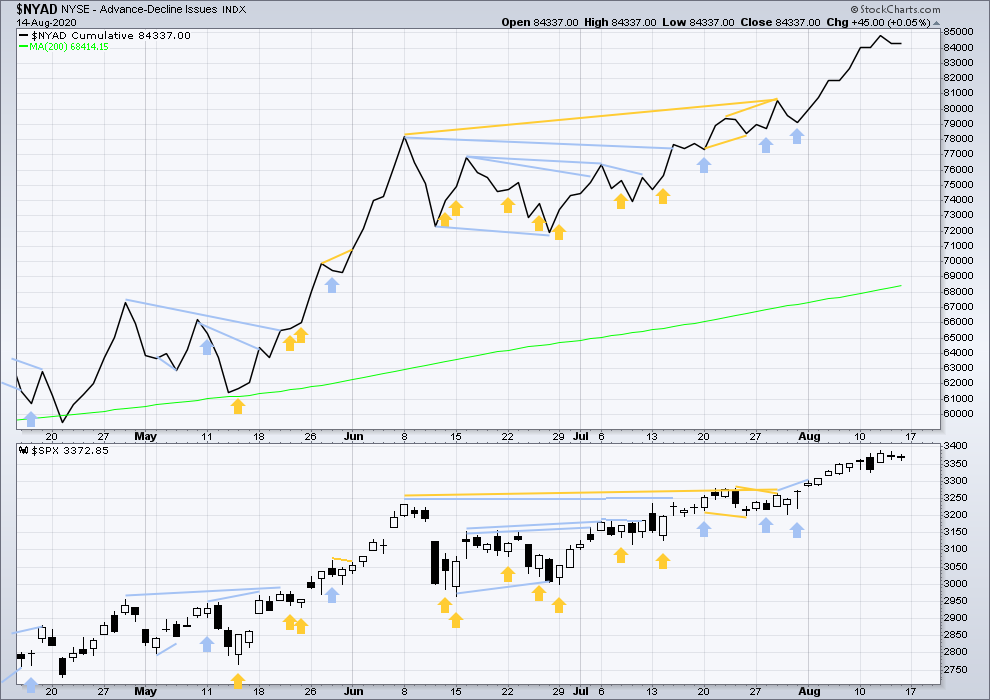
Click chart to enlarge. Chart courtesy of StockCharts.com. So that colour blind members are included, bearish signals will be noted with blue and bullish signals with yellow.
Today price has moved sideways to complete an inside day, and the AD line is flat. There is no new short-term divergence.
VOLATILITY – INVERTED VIX CHART
WEEKLY CHART
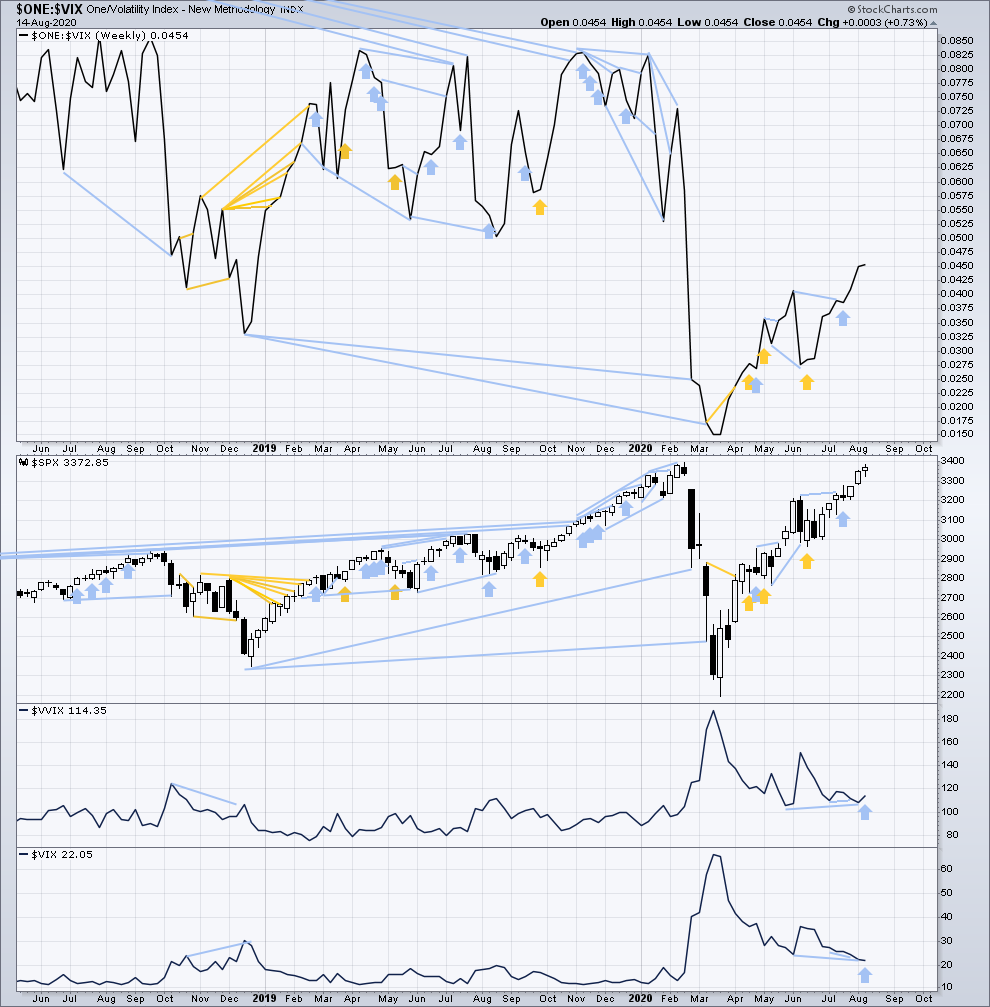
Click chart to enlarge. Chart courtesy of StockCharts.com. So that colour blind members are included, bearish signals will be noted with blue and bullish signals with yellow.
Inverted VIX remains well below all time highs. There remains over two years of strong bearish divergence between price and inverted VIX.
This week both price and inverted VIX have moved higher. There is no new divergence.
Comparing VIX and VVIX: From weeks beginning 1st June to this last week, VIX has made new lows as price has made new highs, but VVIX has failed to make corresponding new lows with VIX. VVIX remains slightly elevated. This divergence is not strong, but it is bearish for price. VIX has moved slightly lower for this last week, but VVIX has moved more sharply higher. This is a week of single instance divergence, which is bearish for price.
DAILY CHART
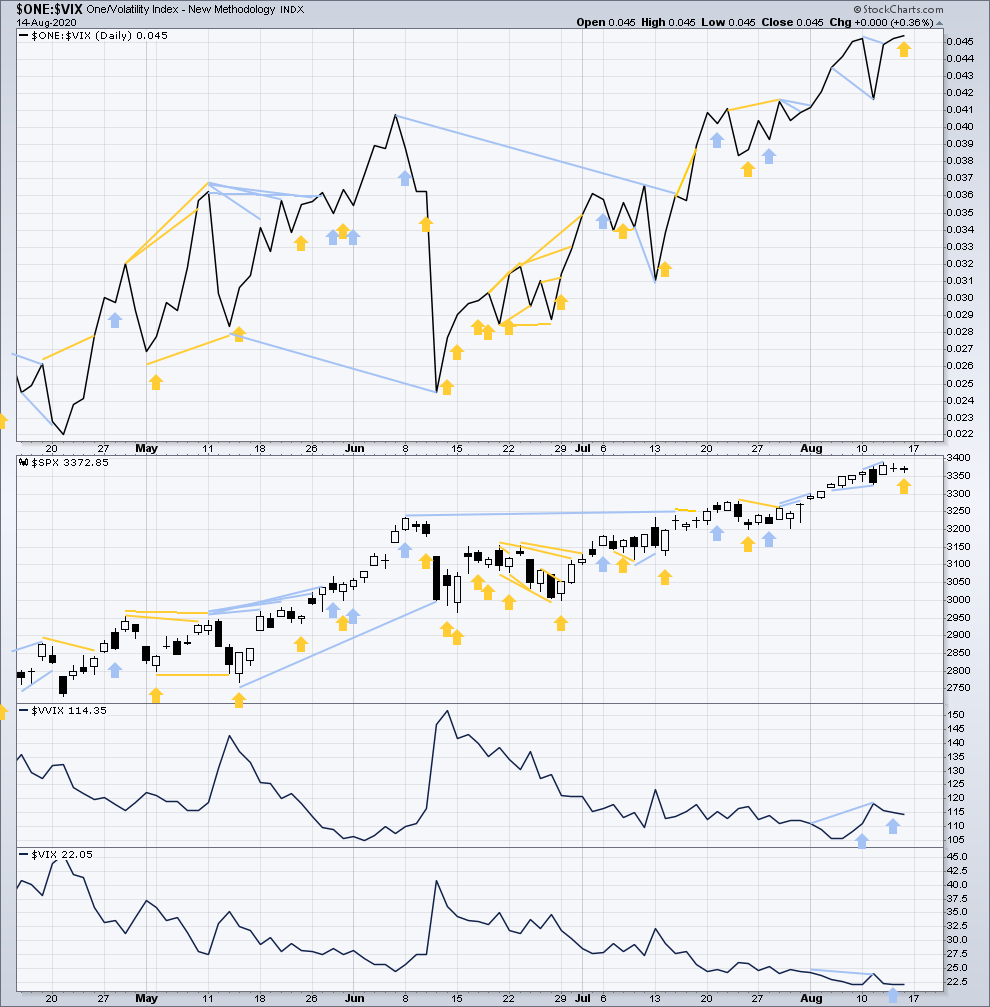
Click chart to enlarge. Chart courtesy of StockCharts.com. So that colour blind members are included, bearish signals will be noted with blue and bullish signals with yellow.
Today price has completed an inside day, and inverted VIX has moved slightly higher to make a new short-term high. This divergence is bullish for the very short term.
Comparing VIX and VVIX at the daily chart level: For Friday both have moved slightly lower; there is no new short-term divergence.
DOW THEORY
Dow Theory has confirmed a bear market with the following lows made on a closing basis:
DJIA: 21,712.53 – a close below this point has been made on the March 12, 2020.
DJT: 8,636.79 – a close below this point has been made on March 9, 2020.
Adding in the S&P and Nasdaq for an extended Dow Theory, a bear market has now been confirmed:
S&P500: 2,346.58 – a close below this point has now been made on March 20, 2020.
Nasdaq: 7,292.22 – a close below this point was made on the March 12, 2020.
At this time, to shift Dow Theory from viewing a bear market to confirmation of a new bull market would require new highs made on a closing basis:
DJIA – 29,568.57
DJT – 11,623.58
Adding in the S&P and Nasdaq for an extended Dow Theory:
S&P500 – 3,393.52
Nasdaq – 9,838.37 – closed above on June 8, 2020.
All of Nasdaq, S&P500 and now DJT have made new swing highs above prior highs of the 8th of June, but DJIA has not.
Published @ 08:00 p.m. ET
—
Careful risk management protects your trading account(s).
Follow my two Golden Rules:
1. Always trade with stops.
2. Risk only 1-5% of equity on any one trade.
—
New updates to this analysis are in bold.

